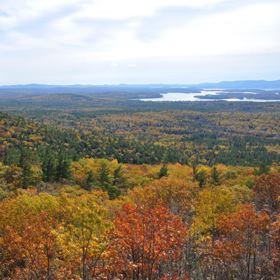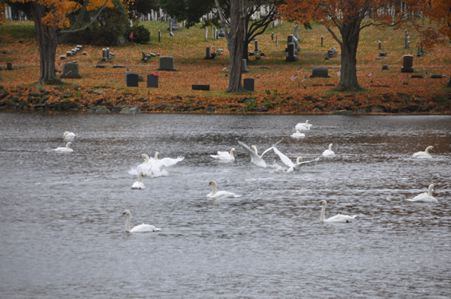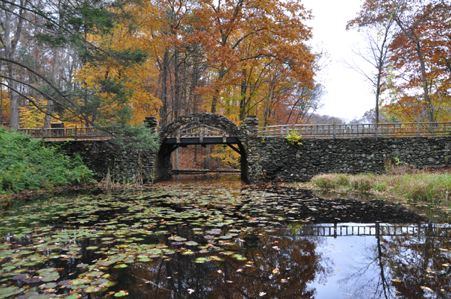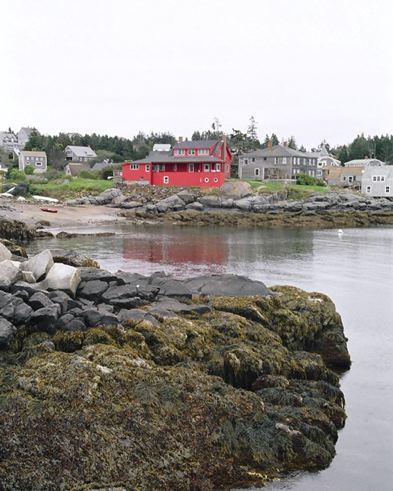 Mention New England at this time of year and the conversation subject will likely turn to where to find great fall foliage. Yes, there are all the colors of the changing season but there are treasures of another sort.
Mention New England at this time of year and the conversation subject will likely turn to where to find great fall foliage. Yes, there are all the colors of the changing season but there are treasures of another sort.
Meg Pier takes us out of the driver’s seat of leaf peeping and into the more experiential side of New England in the fall. Arts & Crafts architecture to steam trains and artist colonies, New England’s multi-faceted identity goes far beyond passive leaf-peeping. The region boasts offshore islands, bogs and river banks that are bastions of an independent spirit, creative flair and Down East practicality.
The rivers of Connecticut, New England’s southernmost state, afford a vantage point that can be enjoyed from vintage vessels.
 A 90-minute cruise aboard the 1908 Sabino, one of the oldest wooden, coal-fired steamboats still in operation, makes for a novel way to enjoy the scenery along the Mystic River. Designated a National Historic Landmark in 1992, the Sabino is one of four vessels with that distinction and can be appreciated at Mystic Seaport, one of the world’s largest maritime museums. The historic site spans 19 acres and more than four centuries of nautical heritage, including a re-created 19th-century village, a preservation shipyard, marine paintings and scrimshaw, and a planetarium.
A 90-minute cruise aboard the 1908 Sabino, one of the oldest wooden, coal-fired steamboats still in operation, makes for a novel way to enjoy the scenery along the Mystic River. Designated a National Historic Landmark in 1992, the Sabino is one of four vessels with that distinction and can be appreciated at Mystic Seaport, one of the world’s largest maritime museums. The historic site spans 19 acres and more than four centuries of nautical heritage, including a re-created 19th-century village, a preservation shipyard, marine paintings and scrimshaw, and a planetarium.
Less than a half-hour away, the 1920s Pullman Essex Clipper departs from historic Essex Stationand chugs along the Connecticut River through scenic towns and past picturesque farms and a millpond with waterfall.
In Deep River, passengers can disembark to board theBecky Thatcher, a Mississippi-style riverboat, for a ride up the river to East Haddam. There, atop
hills known as the Seven Sisters, is Gillette Castle, built by Yankee scion and 19th century thespian William Hooker Gillette.
 The 24-room mansion is a tribute to the creative genius of its owner, who designed its many secret passages, hidden compartments and ornate carvings.
The 24-room mansion is a tribute to the creative genius of its owner, who designed its many secret passages, hidden compartments and ornate carvings.
The estate sits on one hundred and eighty-four acres, most of which are open to the public in accordance with Gillette’s will, which specified that the property
not fall to “some blithering saphead who has no conception of where he is or with what surrounded.”
In the neighboring state of Massachusetts, between the towns of Carver and Harwich are more than 14,000 acres of cranberry bogs. A variety of venues offer appel beyond the visual for history buffs, bird-watchers, foodies and festival-lovers.
A.D. Makepeace Companyin Wareham, which has been cultivating cranberries since the 1800s and is the world’s largest cranberry grower, offers bog tours on weekends in October.Flax Pond Cranberry Companyof Carver features a screening house, which dates to the 1890s; today the building serves as a museum of cranberry history. And the history of all things cranberry is housed in the Harwich Historical Society Museumat Brooks Academy.
 Displays chronicle early Cape Cod settlers being taught by Native Americans to use the berry as a dye and medicine as well as food source, and document the world’s first commercial crop in 1846 by Captain Alvin Cahoon.
Displays chronicle early Cape Cod settlers being taught by Native Americans to use the berry as a dye and medicine as well as food source, and document the world’s first commercial crop in 1846 by Captain Alvin Cahoon.
Against the backdrop of the Berkshire Mountains in Western Massachusetts, Stockbridge has long drawn a diverse cross-section of those seeking inspiration. The Norman Rockwell Museumis dedicated to the work of this long-time resident, and Alice’s Restaurant, made famous by Arlo Guthrie’s Vietnam protest song, is now run as Theresa’s Stockbridge Café. The Kripalu Centeris a yoga retreat that attracts 25,000 annually and occupies a former Jesuit seminary.
In the mid-19th century, Stockbridge attracted wealthy summer residents, who built estates known as Berkshire Cottages. One such “cottage” is Naumkeag a 44-room country house designed by noted architect Stanford White, now a National Historic Landmark and museum.
The word “naumkeag” also refers to a sanding pad used in the shoe industry. Thomas Plant made his fortune shodding New Englanders and in 1913 built a 16-room Arts & Crafts mansion in New Hampshire’s Ossipee Mountains. Now known as Castle in the Clouds, the estate exemplifies the architectural movement’s philosophy of living in harmony with nature, and has a 270-degree view that includes Lake Winnipesaukee, as well as 45 miles of trails that wind through the woods and by waterfalls.
Further north, near New Hampshire’s border with Maine, is another iconic piece of New England architecture, also built by a man who pulled himself up by his bootstraps. By age 30, Joseph Stickney had amassed immense wealth as a railroad tycoon. In 1905, for $1.7 million—or $38 million today—he built the Mount Washington Hotel, bringing in 250 Italian artisans to craft an elaborate structure in the Spanish Renaissance Revival style. A favorite retreat of presidents, in 1944 the hotel hosted the international monetary conference that established the World Bank. Now known as the Omni Mount Washington Hotel and Resort, the property was declared a National Historic Landmark in 1986.
 Off the coast of Boothbay Maine isMonhegan Island, 11 miles out in the Atlantic. Giovanni da Verrazano’s ship landed here in 1525,
Off the coast of Boothbay Maine isMonhegan Island, 11 miles out in the Atlantic. Giovanni da Verrazano’s ship landed here in 1525,
followed by Samuel de Champlain in 1604 and Captain John Smith in 1614. Monhegan Island served as one of the New World’s earliest outposts, harboring British
fisherman and fur traders.
Today, the island is home to an artist’s colony of international reputation. Among the many prominent painters who have found inspiration here are Jamie Wyeth, Edward Hopper and Rockwell Kent. The Monhegan Historical and Cultural Museumis housed in the old Lighthouse
Keepers Cottage.
Barely two miles long, Monhegan has about 17 miles of trails across the two thirds of the island that is protected as a nature sanctuary. The preserve is overseen by a trust founded in 1954 by the family of inventor Thomas Edison to protect the island’s “simple, friendly way of life.”
From October to the beginning of June, fishermen harvest lobsters from the only lobster conservation area in the state of Maine.
Peaks Island is one of over 211 island—and just four year-round islands—located in Maine’s Casco Bay. The island is accessible by a short 20-minute ferry ride from Portland, of which it has been considered a neighborhood, since a failed secession attempt in 2006-2007. The isle has two restaurants that stay open year-round, two inns and a grocery store whose motto is “If we don’t have it, you don’t need it.”
The same might be said for the many spirited and colorful communities of New England.
Related links on PeterGreenberg.com:
- Fall Foliage Travel 2010
- Fall Foliage Getaways: Leaf-Peeping for All
- 10 Affordable Fall Getaways in the USA & Abroad
- America the Beautiful: Postcard from the Edge – Maine
- The Historic Inns of Rockland, Maine
Text and photos by Meg Pier for PeterGreenberg.com. Meg Pier covers travel for theBoston Globeand other publications. Visit her on the Web atwww.ViewFromthePier.com.












